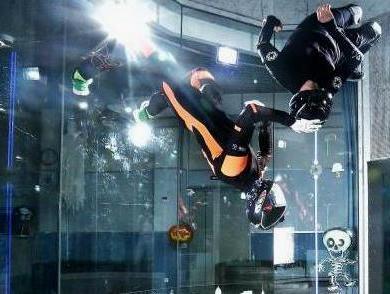
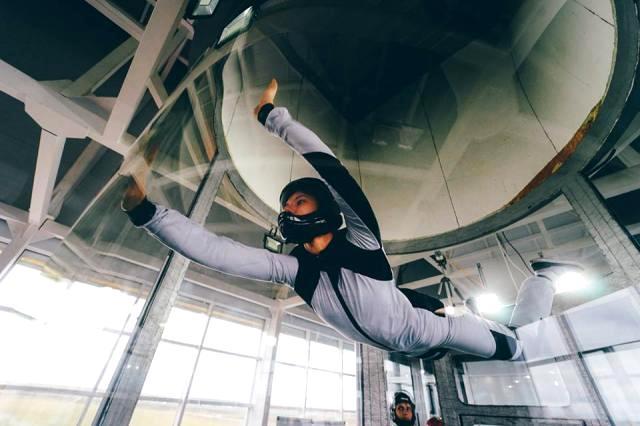



WIND-TUNNEL BODY-FLYING.
FREE-FALL SIMULATOR TRAINING IN MOSCOW.
At the Flight Club skydiving school in Russia, we utilize vertical wind-tunnels primarily as free-fall simulators for a performance enhancing tool when training Accelerated Free-Fall students as well as in the coaching process of licensed skydivers.
For this purpose, we have IBA-rated wind tunnel instructors on staff who can organize tunnel time for you at any of the Moscow area wind tunnels on short notice and to preferential rates.
If you are planning to enroll into an ACCELERATED FREE-FALL COURSE with the Flight Club skydiving school, or if you are a licensed skydiver participating in any of our free-fall SKYDIVE COACHING programs and want to up your current level of in-air proficiency with some additional tunnel coaching, then this page is for you.
Following, we explain how wind-tunnels work, what body-flying is, who this activity is for, how (aspiring) skydivers benefit from training in a free-fall simulator and how to book tunnel time in Moscow.
HOW DO VERTICAL WIND TUNNELS WORK?
Vertical wind tunnels, work similar to conventional wind tunnels used for testing cars, only that, as the name correctly suggests, they stand vertically. Vertical wind tunnels are purpose-built structures to simulate air-flow characteristics similar to those a skydiver experiences in free-fall.
Over the past 20 years, the wind tunnel industry has experienced a boom that is comparable to the roller-coaster mania of the 1950's. Today, you can find vertical wind tunnels seemingly anywhere, from shopping malls to amusement parks and some have even been erected literally in the middle-of-nowhere! There are several different manufacturers featuring both outdoor- as well as indoor models of varying radial- and height dimensions, utilizing varying fan blade concepts which are powered by engines ranging from somewhat weakish to borderline nuclear.
Outdoor models are best characterized as free-standing, mobile devices. Their engines power fan blades located below the flight deck, pumping airflow upwards.
There are no visible boundaries in terms of walls, which is obviously a really cool feature, if you want to fly in highly frequented public places such as beaches, amusement parks or sport stadiums, since the performer really does get the sensation of flying and spectators can witness all the action easily.
The downside to the outdoor models is the design-related technical limitation in terms of airflow quality.
Therefore, for hard-core skydivers looking at things strictly from a "realistic" free-fall simulator point-of-view, indoor versions of vertical wind-tunnels are the popular choice venues.
WHAT IS BODY-FLYING?
Body-flying is the art of controlling your body in free-fall. You can learn to maintain a stable belly-to-earth flight attitude, move forward and backward, fly up and down, turn and go from side to side.
Everybody starts out flying on their bellies, since it involves a naturally and laterally stable body-position, can be applied in low airspeeds and provides for a familiar visual reference.
Eventually though, you will be able to perform the same maneuvers and freely turn, loop and roll around the three axis of your body while flying inverted on your back, sitting or standing in the air and while flying head-down.
All it takes, is for a professional wind tunnel coach to show you how it's done and some time, practice and determination from your side.
WHO IS WIND-TUNNEL BODY-FLYING FOR?
As you now know, the controller can adjust the wind speeds in the flight chamber, there is a spotter inside the chamber for your safety and you learn to fly in a one-on-one format from a professional coach.
Accordingly, a free-fall simulator really is a controlled, safe and indiscriminate environment and virtually everybody can learn to fly there, and we really do mean everybody.
If you ever visit a vertical wind tunnel, you are likely to run into a pretty colorful crowd.
You'll meet kindergarten-age kids trying to find their wings, mom and pops pushing some air around and world-champion skydivers in serious training mode, and all these people alike, going absolutely crazy for this. And we actually do mean "absolutely positively crazy".
Wind-tunnel body-flying is very much a indiscriminate activity, a whole lot of fun and, by the way, very, very addicting ;)
As such, wind-tunnel sessions have, beyond being wildly popular with our skydiving clientele, evolved into one of the best-selling events in the Flight Club CORPORATE PROGRAM.
HOW DO SKYDIVERS BENEFIT FROM TRAINING IN A FREE-FALL SIMULATOR?
For anybody who has never experienced terminal velocity, wind-tunnels are a fun, no-pressure kind of environment to get a real-life idea what 120 mph wind hitting your body, actually feels like.
That's hurricane force wind-speeds and for the first moments you are exposed to this, the sensation is guaranteed to literally take your breath away.
Different to real-life free-fall, there are no survival aspects linked to the wind-tunnel game and thus, student skydivers can fly around without much of a worry. Therefore, the wind-tunnel environment is the perfect place to first get accustomed to the air and make friends with this new element.
With sensory over-load conditions associated with the process of jumping out of an actual aircraft and with you traveling towards mother earth at terminal velocity in a real-life free-fall environment practically eliminated,
wind-tunnel body-flyers enjoy the luxury of being able to direct their attention entirely towards mastering the biomechanical and aerodynamical aspects of flying their body.
During the first few minutes of airtime, wind-tunnel body-flight students effectively find their balance in a naturally- and laterally strongly stable face-to-earth flight-attitude and learn to control their pitch, to both maintain as well as to manipulate their heading and to simulate the deployment sequence as it applies to real-life free-fall skydiving while maintaining stability and heading control.
There is no survival aspect to the wind-tunnel game and thus, student skydivers can fly around without much of a worry and for however long it takes, in order for them to
find their balance in a stable face-to-earth flight- attitude. During the first few minutes of flight, wind-tunnel body-flight students can effectively learn to control their pitch, to hold as well as to manipulate their heading and to simulate the deployment sequence as it applies to real-life free-fall skydiving.
These basic body-flight skills are essentially the very targeted learning objectives which any Accelerated Free-Fall skydiving student needs to master in order to progress through AFF CAT A, CAT B, CAT C1, CAT C2, CAT D1 and CAT D2.
Equipped with these motor-skills, some relatively permanent muscle memory and with new-found confidence in your body-flight skills acquired as part of your wind-tunnel training, you have an excellent chance of translating these skills efficiently into the real-life terminal velocity free-fall environment as it applies to your Accelerated Free-Fall skydiving course.
Experience has shown, that Accelerated Free-Fall skydiving students who have mastered these elementary body-flying skills in a wind-tunnel environment prior to going into actual free-fall, typically progress fairly smoothly through the AFF program, with repeat jumps being rather the exception than the norm.
On the other hand, AFF students who have to figure all this out under sensory over-load conditions and operating under severe time pressure in a live free-fall scenario, are more likely to need a couple of extra attempts every so often to master certain free-fall tricks.
While it stands true that past generations of pilots have all picked up their flying skills exclusively through live in-air application, it' s probably safe to say that nowadays, there are not a whole lot of people in command of fighter-jets and air-liners roaming the skies, without having enjoyed the benefits of supplemental simulator-supported training.
It is for these very reasons and following the same logic, that today, wind-tunnel body-flight training is playing an integral part in the development of motor skills for skydivers of all experience levels and of all levels of in-air proficiency.
There is no current world-champion competition team in any free-fall discipline of sport skydiving, which does not train the biomechanical aspects of body-flight, at least in supplementary form, in a free-fall simulator environment.
Goes to show you.
TUNNEL COACHING FEES.
FREE-FALL SIMULATOR TRAINING (30 MIN FLIGHT TIME):
STARTING AT EUR 225.00
including: 30 minutes effective flight-time, safety briefing, motor- skill development training prior to your flight, one-on-one coaching, debriefing, video of your body-flight, round-trip road transit between the Flight Club skydiving school at Aerograd Kolomna and the wind-tunnel.
As we have stated in our intro, Flight Club tunnel coaches can get you airtime in any of the Moscow region wind tunnels. The above quoted price may vary, depending on what tunnel you choose to fly and just how bad-to-the-bone a personal coach you think it might take for you to master the next trick in your body-flight progression.
So, let us know where you are at in terms of in-air proficiency and budget and we will get you the best deal in town without any of the booking hassles.
Of course, you have the option to surprise someone special with their very own VIP tunnel ticket as part of the Flight Club GIFT CARD program.
HOW TO BOOK TUNNEL TIME IN MOSCOW?
To book tunnel time in Moscow, please speak with us directly in FLIGHT CLUB LIVE CHAT or visit us at the Flight Club skydiving school.
If you are a visiting foreign skydive student, please allow for one extra day in your itinerary to accommodate for your supplemental skydive-simulator training when making travel plans.
SITE LINKS

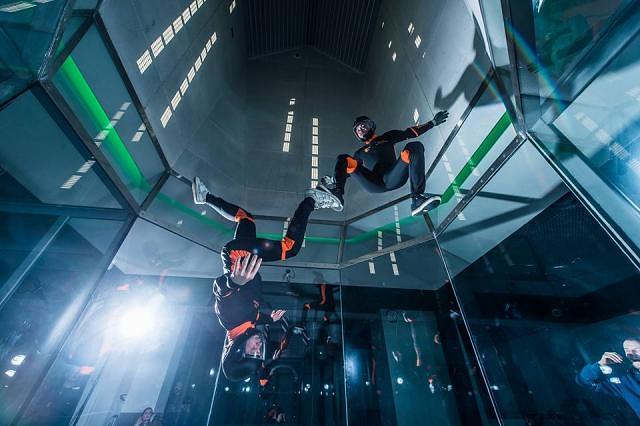
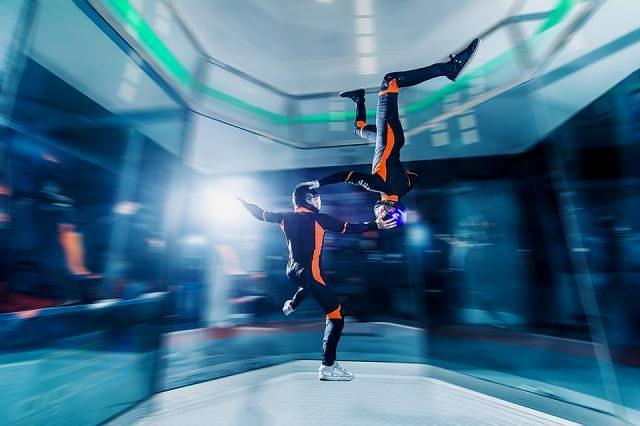
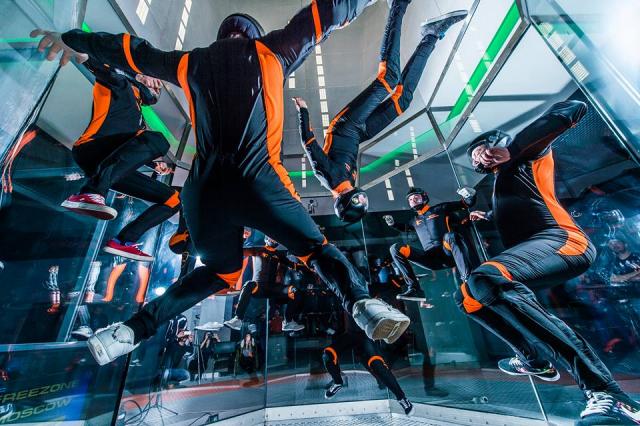
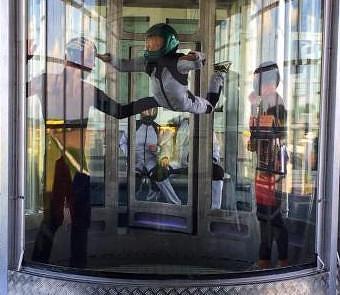
Indoor free-fall simulators are characterized by their external fix structure and a cylinder-shaped, enclosed flight chamber. The flight chamber has a safety netting but is otherwise open to the bottom and features several giant fan blades locate just above the top end of the flight chamber. The fan blades act like a propeller sucking air through the flight chamber, resulting in an upwards-directed, powerful and smooth airflow that allows for anybody inside the flight chamber to hover, thus creating simulated free-fall.
Adjacent to the flight chamber, in the control room, sits who we lovingly call "the driver", a professional controller who overseas the wind tunnel's operating systems and who can adjust engine power settings and therefore the rpm rate of the fan blades.
In doing so, he controller can create wind conditions inside the flight chamber which are custom-tailored to each flyers personal body mass index and suitable for each player's current level of flying proficiency.
Some of the more powerful indoor free-fall simulators feature giant flight chamber dimensions measuring 16ft in diameter and 50ft in height and can create hurricane category 4 type wind speeds in excess of 180mph! So, plenty of space and more than enough power for several people to simultaneously fly around in style.
To keep things sate inside the wind tunnel, a professional spotter is present inside the flight chamber, to make sure nobody is bouncing off the walls or into he safety net while it's game on.